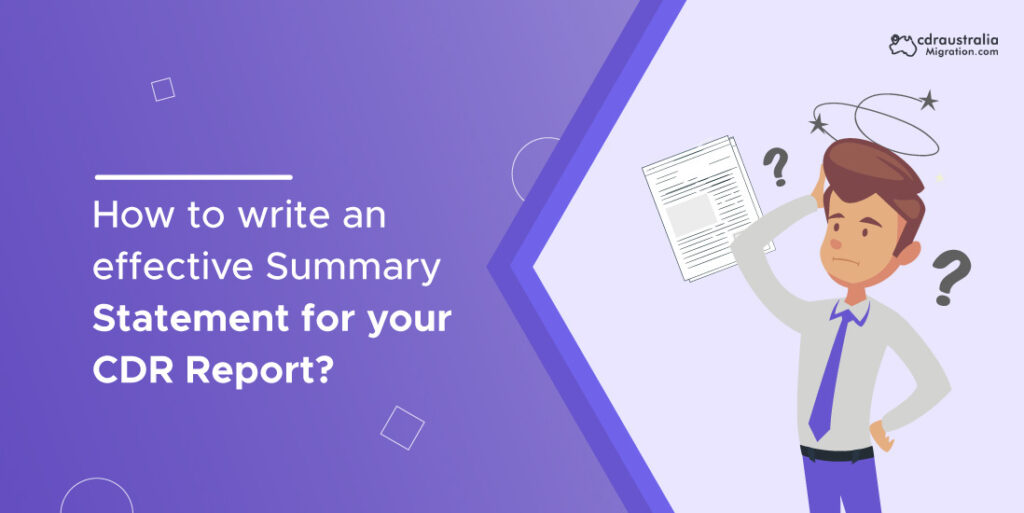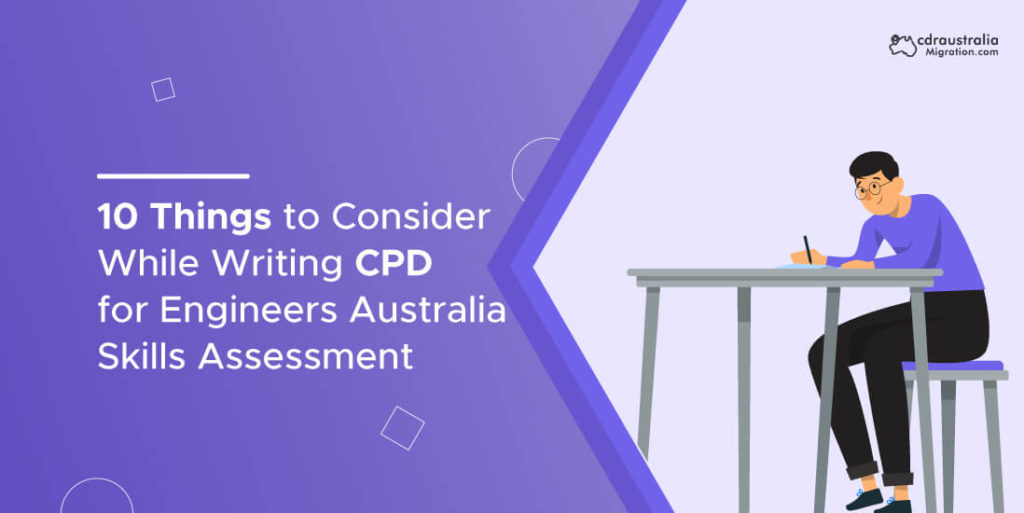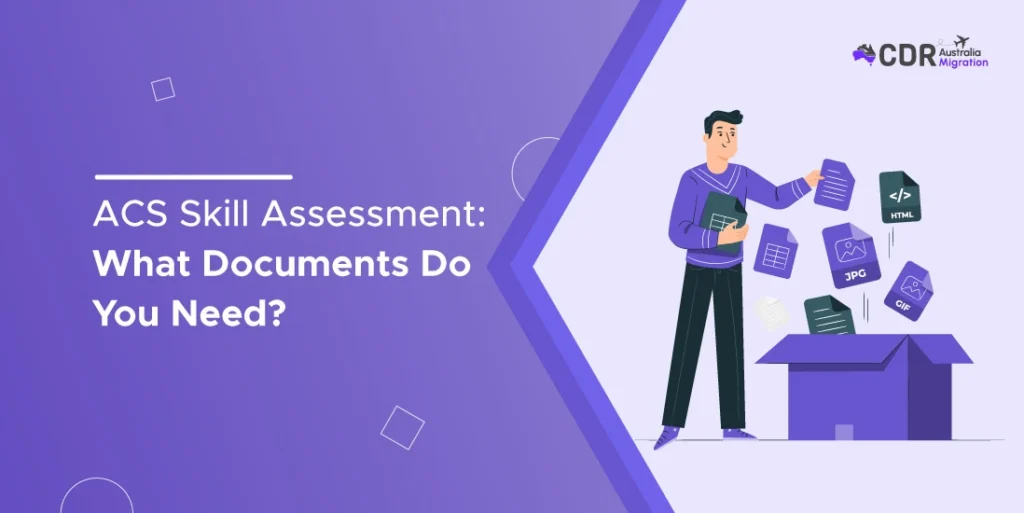The Competency Demonstration Report (CDR) is a vital document for engineers seeking Skilled Migration assessment by Engineers Australia. The summary statement holds immense importance among the various sections of the CDR report as it provides a concise overview of your engineering skills, experiences, and competencies.
In Australia’s competitive field of engineering, a well-crafted summary statement can make all the difference in capturing the attention of potential employers and showcasing your skills and qualifications. A concise and impactful summary statement can help you stand out from the crowd and land that dream engineering job.
In this blog, we will unveil the secrets to writing an effective summary statement for your CDR report. We will guide you through each step to ensure your summary statement shines brilliance and captivates the assessing authorities.
Overview of Summary Statement
The Summary Statement in your Competency Demonstration Report (CDR) highlights your core engineering skills. Ensure your summary statement is easy for the EA assessor to understand. Written in tabular format, it connects with CDR episodes.
To prepare your CDR, create three career episodes showcasing your engineering activity. The summary statement follows these episodes. Evaluate them to cover all competency elements in your chosen occupational group. This evaluation is reflected in the summary statement, which cross-references the competency elements in each paragraph.
Download and complete the required summary statement template for your nominated job category from Engineers Australia’s website. Use them as guidelines for reference. Your Summary Statement can extend beyond a single article. It’s optional to cover all metrics in each competency aspect. Remember, you need only one Summary Statement for all three career episodes.
How to write an effective summary statement for your CDR report?
Preparing your summary statement requires careful consideration and attention to detail. Here are some steps to help you prepare your summary statement effectively:
1. Understand the purpose and requirements.
Familiarize yourself with the purpose of a summary statement and its importance in the context of your specific application or document. Determine any specific requirements or guidelines provided by the target audience or organization.
2. Review the relevant content.
Gather all the relevant information, such as your academic qualifications, work experience, projects, achievements, and skills. Review and organize this content to identify the key elements that best demonstrate your capabilities and align with the requirements.
Read More: Get the idea for preparing an ACS RPL report for ICT security specialists. 💪💪
3. Identify your unique selling points
Determine your unique selling points or strengths that differentiate you from other candidates or applicants. These could include specialized skills, certifications, industry experience, leadership roles, or significant achievements.
4. Prioritize the most relevant information
Select the most relevant and compelling information from your reviewed content. Prioritize achievements, experiences, and skills that directly relate to the purpose of the summary statement or the specific requirements of the application or document.
5. Craft a clear and concise opening
Begin your summary statement with a clear and concise opening sentence that grabs the reader’s attention and sets the tone for the rest of the statement. Consider using a strong action verb or a captivating statement highlighting your expertise or accomplishments.
6. Highlight key skills and competencies.
Emphasize your key skills and competencies most relevant to the target audience or organization. Focus on technical expertise, industry knowledge, problem-solving abilities, teamwork, communication skills, and other strengths that align with the requirements.
Learn More: Find out the most in-demand engineering fields in Australia. 🔎🔎
7. Provide specific examples and achievements
Support your claims and statements with specific examples and achievements. Describe projects you have completed, initiatives you have led, or significant contributions you have made. Use quantifiable results, such as numbers, percentages, or time frames, to demonstrate the impact of your work.
8. Tailor the statement to the target audience
Customize your summary statement to align with the needs and expectations of the target audience or organization. Research their values, mission, and goals to ensure your statement meets their requirements and priorities.
9. Edit and revise
After drafting your summary statement:
Edit and revise it for clarity, coherence, and conciseness.
Remove any unnecessary or redundant information.
Ensure that the statement flows smoothly and maintains a logical structure.
Proofread for grammar, spelling, and punctuation errors.
Editor’s Pick: ANSCO skilled occupations for Engineers Australia. 🔥🔥
10. Seek feedback
Consider seeking feedback from trusted individuals, such as mentors, colleagues, or professionals in your field. Their insights and perspectives can help you refine and improve your summary statement.
11. Finalize and polish
Based on the feedback, make necessary revisions and finalize your summary statement. Ensure that it aligns with the specified length or formatting requirements. Give it a final review to ensure it effectively represents your skills, experiences, and qualifications.
Remember, a well-prepared summary statement can significantly enhance your chances of success in various applications or documents. Take the time to carefully craft a compelling summary statement that accurately reflects your strengths and captures the attention of your target audience.
Things to include in your Summary Statement
When preparing your summary statement, consider including the following elements to make it comprehensive and impactful:
- Professional Identity: Establish your professional or job title to establish your expertise and specialization. This helps the reader quickly understand your professional background.
- Years of Experience: Mention the number of years of experience you have in your field. This provides a quick snapshot of your level of expertise and establishes your credibility.
- Key Skills and Areas of Expertise: Highlight your key skills and areas relevant to the position or industry you are targeting. These include technical skills, software proficiencies, industry knowledge, or specialized certifications.
- Achievements and Accomplishments: Showcase notable achievements and accomplishments from your career. These can include successful projects, awards, recognition, or any significant contributions you have made to your organization or field.
- Industry Experience: Briefly describe your experience in specific industries or sectors, especially if you have expertise in a particular domain. This demonstrates your understanding of industry-specific challenges and solutions.
- Leadership Roles: If you have held leadership positions, mention them to highlight your ability to manage teams, make strategic decisions, and drive results. Leadership experience showcases your managerial and interpersonal skills.
- Educational Background: Include your educational qualifications, such as degrees, certifications, or relevant courses. Focus on specialized or advanced degrees relevant to the position or industry.
- Professional Affiliations: If you are a member of professional organizations or associations, mention them to indicate your commitment to professional growth, networking, and staying updated with industry trends.
- Language or Communication Skills: If you possess strong language or communication skills, especially bilingual or multilingual, mention them, as they can be valuable in cross-cultural or international roles.
- Problem-Solving Abilities: Highlight your problem-solving skills and your approach to overcoming challenges. Showcase your ability to analyze complex situations, propose innovative solutions, and drive positive outcomes.
- Teamwork and Collaboration: Emphasize your ability to work effectively in teams, collaborate with colleagues, and contribute to a positive work environment. Mention any successful team projects or your role in fostering collaboration.
- Adaptability and Flexibility: Adaptability is crucial in today’s dynamic work environment. Highlight your ability to adapt to changing circumstances, learn new technologies or methodologies, and thrive in diverse work settings.
- Career Objective: Conclude your summary with a brief statement about your career objective or what you hope to achieve in your professional journey. This shows your ambition and can align your aspirations with your target organization or position.
Read More: How to migrate to Australia as a Civil engineer? ✈️✈️
Conclusion
A well-crafted summary statement can significantly increase your chances of securing engineering opportunities in Australia. By understanding the specific needs of the Australian engineering industry, optimizing your statement with relevant keywords, and showcasing your skills and achievements, you can create a compelling summary statement that grabs the attention of hiring managers and positions you as a strong candidate. Remember to continually update and tailor your summary statement as your career progresses, ensuring it remains a powerful tool in your engineering job search.
If you need assistance with your summary statement, you can rely on CDRAustraliaMigration. Our team consists of licensed writers who specialize in your specific occupation and are well-versed in the guidelines set by Engineers Australia. With extensive experience in the field, we guarantee high-quality and plagiarism-free reports at competitive prices.
We pride ourselves on maintaining a professional approach in all our operations. Our utmost priority is to deliver top-notch content to our clients. With the best engineers in Australia, we offer unparalleled support in crafting your summary statement and comprehensive services include CDR report writing, CDR report review, RPL report, and KA02 reports.



